- Mik Bromley

- Nov 7, 2020
- 12 min read
Updated: Nov 28, 2020

Video game art certainly has many facets and stretches back way before the recent expansion of virtual photography into the wider consciousness through the advent of consumer-level photo modes. Much more than just photography, the history of game-derived creativity includes the ever-imaginative Demoscene and novel forms of music creation, as underground movements took video games well beyond their mere intended use as a game to play.
Of course, things have changed a lot over the years and while some people's involvement in video game art may come and go, others keep finding new ways to move forwards with fresh project inspirations. One such serial creator is Melbourne-based fine art virtual photographer and digital spaces artist, Drew M. Taylor, and so it is a great pleasure to welcome Drew onto the blog to talk about his latest work, Fortnite x Battle Royart.
Featuring virtual photography that looks to challenge preconceptions, the project shares captures from free-to-play battle royale title Fortnite via the @BattleRoyart Twitter account, as well as the recent and stunning virtual exhibition gallery entitled, "The First 100". Let's learn a bit more about Drew then, and the inspirations behind his latest expressive concept.

- Fortnite x Battle Royart // The First 100 -
Thanks for joining me Drew, let's start with a bit about yourself and the road you took to today's virtual photography...
Arguably, my first game photographs were taken in the 1980s. I owned an Atari 2600, and Activision had a challenge for many of its games where you could send in a photograph of your television showing you’d beaten a certain score and earn yourself a cloth patch. There was no such thing as a digital camera back then and I remember the terror of taking a photograph of my old CRT TV, realising that it would be weeks before the film was developed and I could be assured the photograph(s) had turned out. I sewed the cloth patches onto a tracksuit top that I still have (and cherish) to this day.

Jump forward about 20 years and my interest in virtual photography as we know it now really began with the gaming art culture movement of the late 90s and early 2000's. Duncan Harris and Dead End Thrills was seminal, along with the works of John Paul Bichard, Brody Condon, Cory Arcangel, iam8bit & Robert Overweg, the research & art curation of Helen Stuckey, the All Your Base meme, the appearance of Lara Croft on the June 1997 cover of FACE magazine, and the wave of machinima that swept the world.
Around that time, I was a graphic designer working in magazine publishing before later moving into games PR and marketing, and in 2005 I designed and published a national art / gaming magazine called JumpButton. I was already screen-shotting lots of games at that time, mostly indie art games because they were what interested me, and wanted to become heavily involved in the art / gaming world.
In 2006, my wife and I had triplets. Two of our children are autistic and have numerous developmental and behavioural issues. Everything changed. Many of my dreams were put on hold or drastically altered. Where I could, I created digital magazines, zines, lo-fi art, showcased virtual photography on websites and more. I also produced a gaming glitch-tography book on No More Heroes, co-created AlphabeNt with artist / photographer Daniel Purvis - a book with a series of art cards created from glitching letters found in games and game logos (which itself went on to be showcased at the GLI.TC/H 20111 festival in Boston).
I don’t want to take “pretty, perfect pictures”...
By the mid-2010s, there were numerous games with photo modes in them that I played and photographed, but, unequivocally, it was Horizon Zero Dawn in February of 2017 that was the game changer. While Sucker Punch deserves a lot of credit for their great work on the inFAMOUS series, Guerrilla’s HZD was a masterpiece, and so was its photo mode. I spent the year playing, shooting the game and dreaming how I could elevate the photographs I was taking to art gallery status.
As PAX Australia panel submissions were opening, I reached out to Guerrilla Games to ask if they would be willing to join a discussion about game photography and boldly proposed a community exhibition of Horizon Zero Dawn shots along with an idea about how that could happen. Some weeks later, I received an email from Sony’s marketing team in Europe telling me to expect a call from Sony’s Australian PR team. They had developers coming out and wanted me to help make the exhibition happen.
The next few months were the craziest, busiest, most amazing months ever. I had never created or curated an art exhibition, but something in me knew I could do it. I reached out to virtual photographers around the world – many of whom I still count to this day as the dearest of friends as a result – and in late October we put on a full scale art exhibition of virtual photography, professionally framed and hung in the main plenary foyer of the Melbourne Convention and Exhibition Centre for the 50,000 attendees of PAX AUS 2017.
It even included a specially created set of Horizon Zero Dawn: The Frozen Wilds shots captured by Guerrilla prior to its release
The last few years have been challenging for a number of reasons, but this year has been marked by the desire to do more projects. I designed a virtual photography magazine, a book about dealing with sadness through virtual photography, co-founded the VGP Network where I currently act as an admin and, more recently, created this virtual gallery.
Such a fascinating and inspiring route to get you to where you are now! With a background in both publishing and game promotion, do you think this influences how you approach any particular title when it comes to photographing it?
Without a doubt, it does. But how it manifests itself is broad and varied. I realise how privileged and fortunate I’ve been. I have done things, been places and had experiences many VPs (and gamers) may not ever get to do or experience, and I’m always acutely aware of that.
For better and worse, it has also afforded me an appreciation and an understanding of how the games industry works, at least in terms of development, media, marketing and PR. This bleeds into my art and my attitudes regarding how I approach games; what I want to visualise, portray and say through my virtual photography.
It sounds caustic but, more and more, I don’t want to take “pretty, perfect pictures” (even though I like looking at other people’s!). As I grow into maturing my own ideas and style, I imagine I’ll start to take less of them… and be happier.
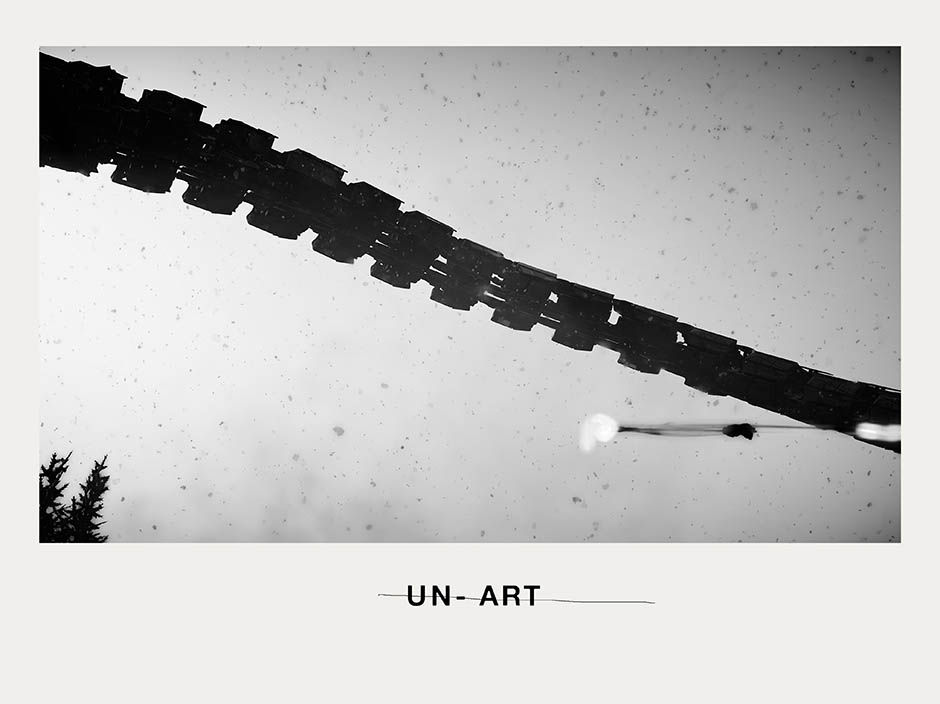
- Un-Art // Drew M. Taylor -
Thinking about your latest project then, what was the inspiration behind Battle Royart and why did you choose Fortnite as the subject game?
It was a culmination of things...
After my very deep and heavy experiences photographing Control, I needed to play and shoot something lighter, something different. I tried a few games, but never got into them. At the same time, because of the Covid lockdown, my daughter had started playing Fortnite with all of her girlfriends as a way of socialising with them. They’d Facetime on their phones and chat, while playing with each other on their iPads.
Then, while moderating the VGP Network, I spotted Fortnite shots by @OneFortniteShot and @Its_B7ack. I’d considered doing virtual photography in Fortnite three years ago, but had never seen a way to get rid of the HUD properly, and it was all “from-behind” third person. These shots, however, seemed to overcome these aspects. I quickly learned from a handful of VPs that you can use the replay mode and it contains its own photo mode. I was immediately interested.
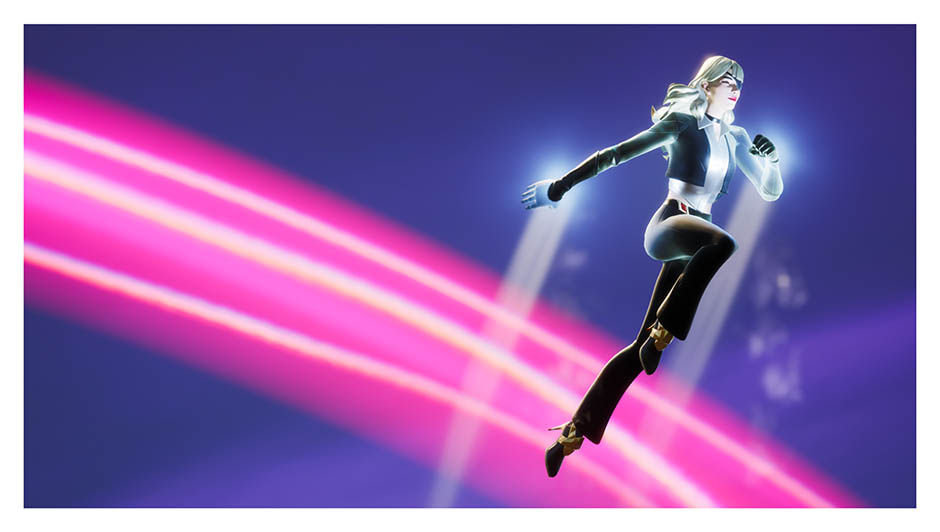
- Strawberry Joy -
A huge limitation of most games is that they are static. The game comes out and, even if it’s open world, the world stays more or less the same. Not so with Fortnite. The “island” changes constantly and can undergo some massive remodelling in every chapter (10 - 12 weeks). For me, this means there will always be something new to photograph and I can stay with this game for as long as I choose to.
Also, the world is charming and despite being a “competitive” game it doesn’t take itself seriously at all. I find the art style pleasing – even if the optimised-for-large-scale-multiplayer textures and settings can be challenging to shoot – and it reminds me of World of Warcraft as a cultural phenomenon. As a mirror on society, it has a lot to say.
You mentioned the replay mode, give us some more insight into the capture process on your Fortnite shots; is much of your work done with premeditated ideas or do you find inspiration on the fly?
Yes, the most specific aspect is the use of the replay mode to do your captures after the match is over. This means there is no immediate feedback. You can’t really check on exact character positions or what will show up in the background; you’re playing in third person so you don’t really know what your character is looking at; and there’s almost nothing pre-scripted about the other people in the world. Quite a lot moves and changes from match to match and, of course, I’ve already mentioned the optimised environments, which especially impact console players / VPs (like myself).
On the plus side, you can look at all of the above as opportunities, and replay mode offers you the ability to scrub through time, free-cam anywhere in the world and revisit the replay over multiple sessions (well, until a regular game update or patch comes through and then you lose the replay forever).

At times, I feel like a hare in a map full of wolves.
As for methodology, I mostly let my energy and my mood determine what happens. Some nights I go into the game with a firm question or idea in my mind and I map things out like placing marks in a stage play, repeating the performance until I have what I want. Other times, I will simply load up the last replay and go in with zero expectations. I find this method is best for surprises. It frees up your creative mind and allows you to be curious and open to ideas and shots that simply present themselves in the moment. It may not produce the uber-stunning VP shots that get all the likes by following very specific design principles, but they allow the unseen to be seen, for the new to emerge.
VP art at its best, for me, is a conversation. A connection. A give and take with the game world.
I love the way that virtual photography involves you with the game world, it can be a solitary pursuit at times though; does using an inherently multiplayer game change that?
Surprisingly, no. Mostly because I don’t orchestrate shots with others (though I have thought about it!). If anything, it can make taking photographs more solitary as I’m often working at cross-purposes to everyone else in the game. They are trying to kill me. I’m trying to stay alive long enough to get to this spot on the map and do this certain thing (whatever idea I have in my head at that time) in the part of the day / night cycle that produces the right kind of light. At times, I feel like a hare in a map full of wolves.
If I can be vulnerable here, it’s more solitary when I’m posting photos or wanting to talk about Fortnite art and photography. Few people see it as a VP-worthy game. Many don’t care for it, so they don’t see the value in it. That’s a tension I deal with all the time. But I’m used to walking the path less travelled. I prefer it; there’s a freedom in it.
Of course, I also play Fortnite to unlock new outfits and for fun - and that can involve others. Sometimes I play “Duos” with my 13-year-old daughter and, less frequently with friends from the States (time zones permitting).

- A Hiss Called Sadness -
A lot of your recent work, such as "Off Map Magazine" and the particularly powerful "A Hiss Called Sadness", use a stylish and beautiful magazine format; what made you move away from that for "The First 100"?
It would appear that way, but I don’t think that style goes away even in a show set like “The First 100”. Many of the shots taken for the Battle Royart Twitter account use photography’s ability to compress space and “flatten” the world to create a strong graphic style. You can see it most in shots such as Rift Flower, Strawberry Joy, Hidden Chest, Gorger Baby Art Project and quite a few others.
I think this exhibition can be seen as a first step for me. As I gain confidence with my Fortnite art and photography, I’ll be pushing deeper into the space where words and images come together to create messages and art.
Some of the shots here may be unrecognisable as Fortnite to many people; is that something you like to try and achieve?
Very much so. I want there to be an element of disbelief. A huge compliment to me is hearing someone try to reconcile their preconceptions of what Fortnite is with the images they are viewing.
I feel that there's so much still to explore in our field.
I'm moved by a verse in the Bible (2 Cor 5:16) that calls us to no longer see people as the world does, but as God does. Every day, we are written off by people - judged by social media, the things we have, how popular we are, how photogenic, how clever. But God sees beyond all that, to our core. To who we are and what we can be. And he loves what he sees there. Somehow, that's become the way I approach virtual photography. I want to find the beauty or the image that everyone misses, even if it's imperfect beauty. Or, probably more accurately, even if I'm imperfect at capturing it. We all are imperfectly perfect.
The titles add as much as the visual content in some cases, "Adrift" being a good example. How much do you try to convey meaning with both the words and the image?
My photography is very much an extension of myself. Of my heart, mind and spirit. There's something very sad about this photograph, particularly when you put it into the context of this NPC's normal behaviour, and I wanted that to come through in the title. Not only is the bot adrift in the strict meaning of the word, but in its life and purpose is as well. It's alone.
I find that, creatively, I often feel like this - even if retrospectively I can see within the bigger picture that my work has a common narrative. So, yes, definitely, the titles that I give to shots are important to me. But sometimes I will also be dispassionate and matter of fact with titles – though, that, too, is often intentional.
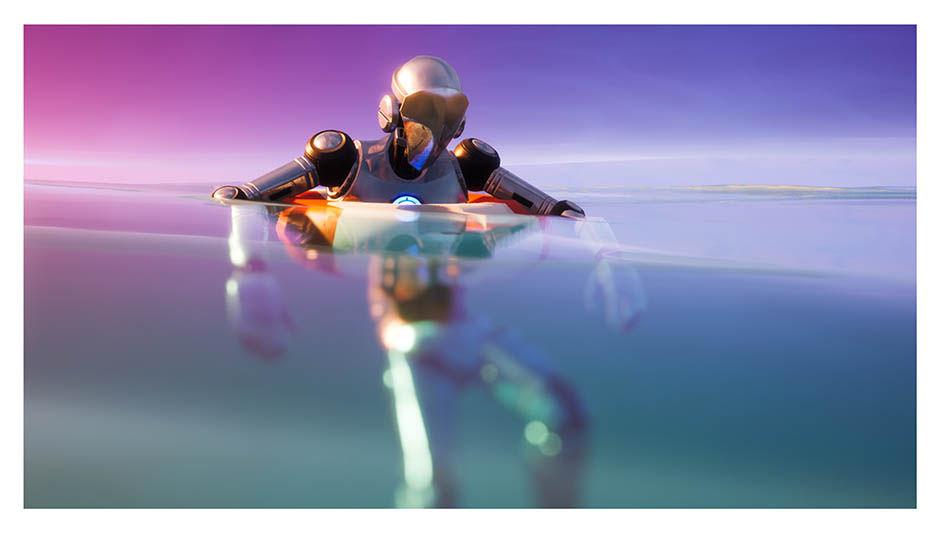
- Adrift -
Do you have a favourite shot?
I find favourite shots are rarely the best photographs. They are usually the ones that are the most meaningful to the photographer.

- Gorger Baby Art Project // and variants -
Rift Flower, Change In The Weather, Box Dash, Mystery Shack, Strawberry Joy, Adrift and Shattered Dawn are contenders, but I think Gorger Baby Art Project (particularly Final Variant) would be the one I’d have to settle on. It was the first time I really felt like I’d pushed Fortnite to create art in a style that most would never dream possible with an unmodified version of the game. It was so rewarding as a digital spaces artist.
One that caught my eye is "Box Dash"; tell me, are they running towards or away from something?
Both. And, also, out of something (the box). I could explain how the shot was created and the setting, but I prefer the viewer to decide on the story. What's going on here? What just happened? What's just out of view, around the corner? In my opinion, that idea of not showing everything makes for a more compelling shot.
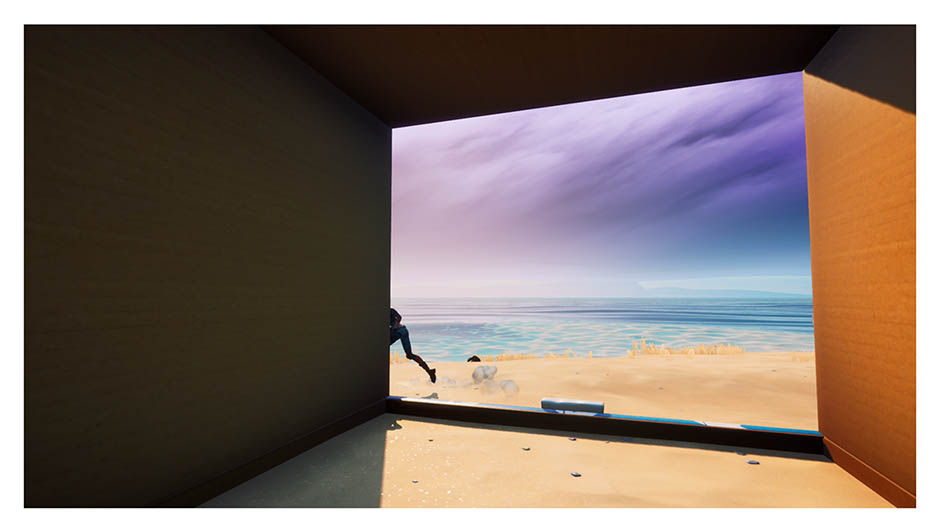
- Box Dash -
A capture that I personally think has some symbolism is "Windsock"; a visual metaphor for the added wind in your sails from working on this project. How would you respond to that?
Windsock was one of my earliest shots and it really became seminal in how I approached my Fortnite photography. Over 100 shots later and it still adorns the Battle Royart Twitter banner and defines the channel's colour palette. It's not a perfect shot and the composition is incredibly simple, but it's the kind of photograph you can stand still in front of and become mesmerised by. When I look at it, I can feel the volume of air that fills the inside of the windsock, but there's also this incredible stillness about the shot. We need that duality.
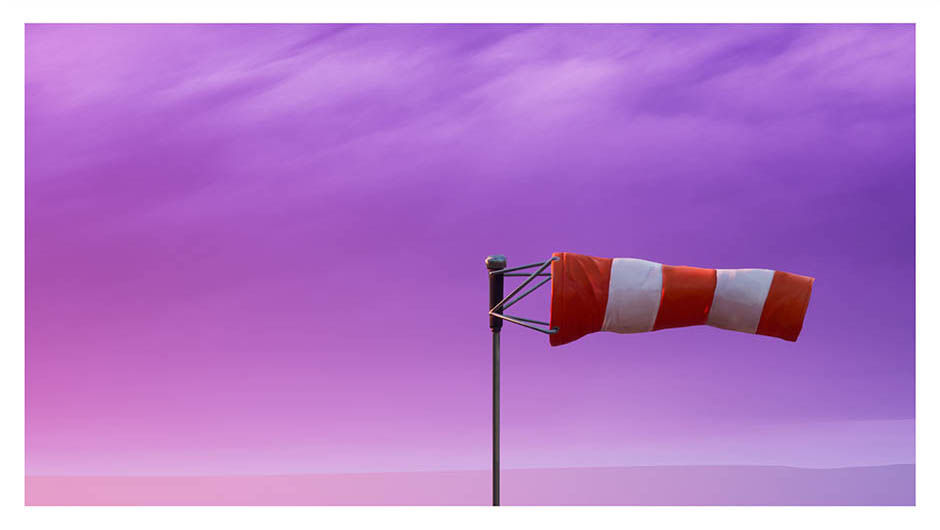
- Windsock -
What have you got planned for your future in virtual photography?
That's a very appropriate question to ask right now. I've been doing a lot of thinking about my photography and where I sit in the community. The talent pool of virtual photographers is already beyond impressive and the quality of photography being captured will only become more breath-taking as we move into the next generation of games. But I still feel that there's so much still to explore in our field.
Over the next few weeks, I’m going to continue to position myself as a fine art virtual photographer and digital spaces artist. I want to speak more through my shots and my art about what is important to me; how I feel about the world and what I would like to say to those around me. I believe in “imago dei” (that we are created in “the image of God” and God loves us) and I feel a very strong sense to take that creative spirit in me and do something more with it; connect with others and resonate with God’s spirit. Where that journey will lead me, I have no idea. But I want to find out.
Amen to that, I look forward to seeing where the creativity takes you this time. Is there anything else you'd like to mention that we haven't already covered?
*laughs* I’m sure I’ve written too much already!
That's it from both of us then and I really hope that you, the reader, have enjoyed this fascinating insight into Fortnite x Battle Royart // The First 100 and the talented creator behind it. A big thank you to Drew for joining me and please do check out his Twitter profiles @DrewMTaylor and @battleroyart.









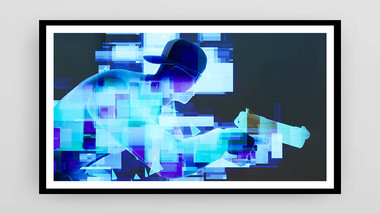




















Our Escorts Vasant Vihar is known for having the best, most beautiful and charming Escorts Service in Vasant Vihar! Our Escorts girls are beautiful, charming, sexy, fun, intelligent, cultured and a pleasure to be with enabling you to make the most of your time together.
Since joining Fulfilment, my business operations have become smoother. Their 3PL fulfilment is spot on.
Experience GFE with a focus on cuddling and intimacy with our Delhi hotel escorts. Enjoy comforting and sensual companionship for discreet, emotionally satisfying experiences. Feel cherished and connected.
Hotel Jaypee Siddharth Escort Service
JW Marrriott Hotel Escorts Service
Escorts near Sheraton Hotel
Call Girls near The Taj Palace Hotel
Call Girls in Ramada Hotel Gurgaon Central
Patparganj Escort call girls are not merely models; they are skilled experts who understand how to please their customers. They are happy to satisfy your wishes and provide a variety of services, such as oral pleasure and sensuous kissing.
Kaiser OTC benefits provide members with discounts on over-the-counter medications, vitamins, and health essentials, promoting better health management and cost-effective wellness solutions.
Obituaries near me help you find recent death notices, providing information about funeral services, memorials, and tributes for loved ones in your area.
is traveluro legit? Many users have had mixed experiences with the platform, so it's important to read reviews and verify deals before booking.